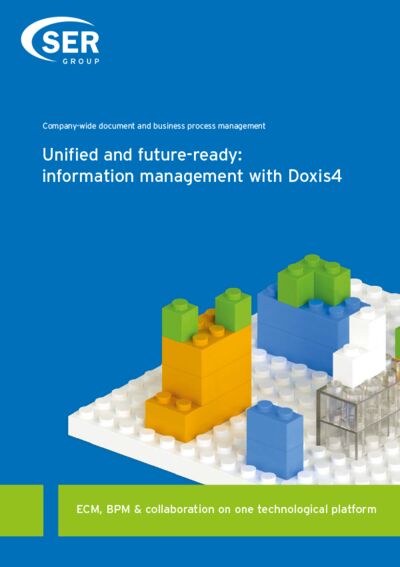SER Blog Innovation & Technology
AIIM's State of Industry – Content Services: 7 key takeaways
When planning the next steps of your digital roadmap, there’s no getting around answering a few hard questions: What are the problem areas in your information management (IM)? And how do you plan to solve them? Content services are often a part of the solution. The challenge lies in figuring out where content services will generate the biggest benefits – for users, but also for the company’s performance, profitability and information governance. The 2019 AIIM study, “State of Industry – Content Services,” surveyed over 300 decision-makers from around the globe to find the answers. We’ve summarized seven key findings here for you.

1. Survival of the digital fittest
The study kicks off by addressing the digital transformation journey. According to AIIM, this journey is focused on one thing: customer experiences. How well companies understand, anticipate and redefine customer experiences, the study says, depends on their agility and innovativeness, their operational excellence and their ability to automate compliance and governance. Information, it says, is “the currency that fuels and funds the journey” as a company’s most valuable asset. The study respondents agree: Almost 80% see digital transformation as important to their survival.
2. Document management and RM – biggest strengths
Okay, so the majority see digital transformation as vital to their survival. But just how far evolved are the respondents in their information management? AIIM asked them to score the maturity of the “building blocks of intelligent information management” in their organization. On a scale of 1 to 3 (3 being “advanced”), the highest level of maturity was in Document Management (2.00), followed not too far behind by Records Management & Preservation (1.94). As these two areas are considered first generation content management capabilities, it makes sense that the highest levels of maturity are found here. What makes less sense from our perspective is why such first generation capabilities do not score higher. However, the emergence of tougher data protection policies – the EU GDPR being the big one – are forcing companies right now to bring these IIM building blocks, e.g. document management and RM, up a notch. As AIIM adds: they are “starting to be table stakes in the drive to digital transformation.” No company can afford to stop innovating and modernizing first generation capabilities. Looking at the spending plans of the respondents, it seems they agree. The highest average spending last year was on Document Management ($215k) followed by Records Management ($195k). Furthermore, respondents say they plan to spend the most in 2019 on the area of document management.
The most mature IIM technology building blocks
Business Process Management
1.77
Records Management & Preservation
1.94
Document Management
2.00
Content Migration, Integration & Collaboration
1.78
Source: "State of the Industry - Content Services," AIIM 2019; scale of 1 to 3 (3 = "advanced")
3. Team productivity biggest must-have in content services
Now that we know where the respondents see their strengths in intelligent information management, let’s look at how they use content services to solve problems. The number one (30%) use case for content services was “team productivity”, i.e. “providing knowledge workers access to content in the context of their project or work tasks.”
The way we see it, one effective way companies can boost team productivity and enhance user experience is through virtual project and data rooms, as a collaboration solution built into a content services platform. In this shared space, users can work on and share information while also securely integrating not only customers and suppliers, but also project partners, development partners, experts, etc. from anywhere. The benefits of effective team productivity go well beyond helping teams: it also boosts employee retention, cuts project delivery time, and increases agility – all of which improve the bottom line.

Unified and future-ready: information management with Doxis
Company-wide document and business process management
Download4. Content integration into business processes is key
Business process applications and the close integration of content and business processes, 26% of the respondents say, are also a crucial use case in content services. In line with this statistic, 44% of the respondents list “content integration into core business processes” as the most important capability of a content services platform. For respondents identified in the study as “laggards” (companies that are still in the first-generation content management basics of document and records management), “integrating content management capabilities into core line-of-business applications” is their biggest challenge. Reflecting the importance of this, 84% of the respondents say that they will either continue with current spending or spend more on “content migration, integration & collaboration” over the course of 2019.
Content, as AIIM says, is shifting from being a stand-alone priority to being a key enabler of processes and analytics. Content federation is undoubtedly one means of consolidating information silos and unifying content from all sources. Regardless of where content is created or stored, content federation makes sure that your company’s data and intelligence are kept actionable. A key advantage of content federation is that it provides you with a 360-degree view of your information, and thereby of your business processes. To fully integrate content into business processes to glean the most business insights, organizations should take a holistic approach and invest in a content services platform that unifies ECM, BPM and collaboration.
5. Information governance through automation
The third most important capability (36%) was “built-in records management across the lifecycle of information”. In this age of tightening compliance requirements and the growing need for governance concepts, it’s easy to see why RM capabilities are in the top three. In fact, when asked how important it would be if they could “transform the processes related to information protection and compliance and automate the management of all of the information tied to those processes,” over 50% of the responding organizations said it is “highly important” or a “deal changer” for their competitiveness. Despite its importance, 48% of the respondents say that getting their C-levels to come up with a solution for information governance is a problem. Furthermore, 70% of the respondents say that key governance processes are still less than 50% automated.
The potential of automation, from our perspective, is immense in the area of information governance. Through automated classification and extraction, information is assigned metadata and placed directly in the right repository with the necessary security settings – starting already in the mailroom. Automated information governance processes also give the added assurance that the information lifecycle is seamlessly documented and transparent, and thus ready for internal/external audits or eDiscovery. Any information applicable to the EU GDPR or other regulations, such as personal data, is automatically flagged and assigned the appropriate retention rules. The list of possibilities goes on. The overriding benefits are first and foremost security, but also increased productivity and searchability. This most strongly affects users, who through automation have less manual work and higher accuracy rates, which avoids compliance breaches and saves time and money.

Compliance with Doxis
Are you about to launch an ECM system? Then you'll quickly find yourself dealing with a myriad of legal requirements and vendor specifications that have to be fulfilled! In this situation, certifications can offer you orientation and security: They attest to an ECM software's compliance with legal guidelines and industry standards.
Download6. Risk vs. value – have your cake, and eat it, too!
When trying to persuade their C-levels to focus more on information governance concepts, the respondents were asked which is more crucial: the value of information assets or the risks involved in managing them? For almost 50% of the respondents, risk and value are equally important. AIIM makes an interesting point here when it says that, “For many organizations, the link has yet to be effectively made between the prudent management and stewardship of information assets and the ability of an organization to use this capability to deliver enhanced value and customer experiences.” Essentially, why not have your cake and eat it, too? Information governance does not necessarily mean you have to miss out on crucial business insights. The two do not exclude one another, as AIIM points out.
7. Unstructured information – a growing challenge
The challenge of managing, storing and protecting unstructured information remains a significant hurdle for companies that want to utilize machine-learning technologies. The respondents said that in the next two years, they expect that over 60% of incoming and existing information will be unstructured. This is a major problem for those who seek to integrate content analytics into their information management. According to Gartner’s “Hype Cycle for Artificial Intelligence, 2018,” AI technologies such as machine learning will be ready for mainstream adoption and have a transformational effect on business. Given that excellent data quality is an absolute must for top ML results, this is a considerable challenge that companies must confront. SER Group CTO Dr. Gregor Joeris also sees this critically, “Unstructured data, if ignored, will lead to a black box in your AI-generated insights.”
The most important capabilities of content services platforms
Content integration into core business processes
44%
Flexible & hybrid deployment models
39%
Built-in records management
36%
Automated categorization & classification
35%
Source: "State of the Industry - Content Services," AIIM 2019
The future of content services
The 2019 AIIM study breaks down the role of content services and automation for organizations on a detailed level. Ultimately, four content service capabilities emerge as the most desired among the respondents: content integration into core business processes (44%), flexible and hybrid deployment (39%), built-in RM (36%) and automated categorization and classification (35%). While content services are the most important element of the “holy” IIM trinity (content, process and analytics services) right now, organizations anticipate a shift in focus towards analytics and automation over the next two years. In other words, content and analytics services – working together – will provide organizations important synergies to manage information in a more cost-effective, secure, streamlined and intelligent way.
As the first content services platform on the market, the SER Group is continuously extending Doxis’s technological lead. We are the only vendor that combines content, process and cognitive services on one uniform and modular platform to achieve the maximum return on information. Want to learn more? Contact us, we would be happy to talk with you about the possibilities of Doxis in your organization.

Maureen Cueppers
Hello there! My name is Maureen Cueppers and I’m the Head of Content & Communications at SER. Analyzing, breaking down and clearly explaining the trends & possibilities of intelligent content automation for our readers – this is always at the heart of my writing. A native of Oregon (USA), I’m a craft beer enthusiast and have 43 nicknames (the last time I counted).
The latest digitization trends, laws and guidelines, and helpful tips straight to your inbox: Subscribe to our newsletter.
How can we help you?
+49 (0) 30 498582-0Your message has reached us!
We appreciate your interest and will get back to you shortly.




